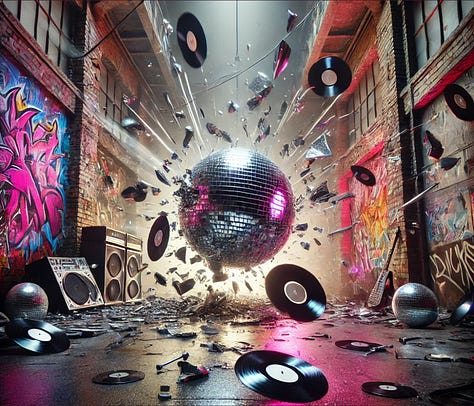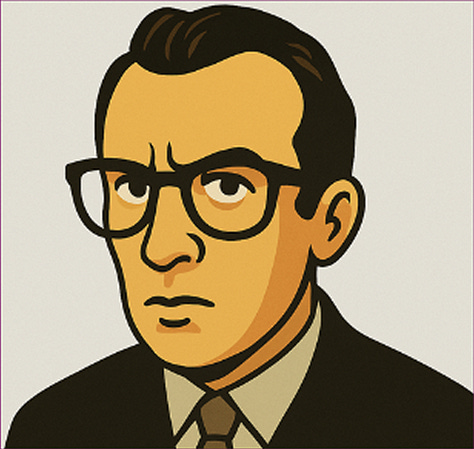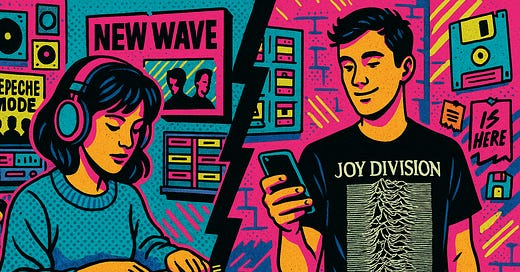1. Definition
In the late 70s, punk as a counterpoint to the mellow and sprawling sounds of much of ‘70s rock (Sorry AOR and Disco ($)!). The simple, confrontational style was a welcome change of pace and a great way to vent. Punk later splintered into 3 styles:
Post-punk added spooky and experimental sounds in the mix
Hardcore punk cranked up the intensity
New wave polished punk to make it more accessible.
Think of it like a rock tumbler: You put rough stones in it, wait a bit, and out comes polished rocks.



2. What’s New Wave’s Special Sauce?
All Hail King Synth.
New wave bands and artists to varying degrees adopted synthesizers in their music, making their songs more electronic-sounding. Del Shannon in the early '60s, along with others until the mid-70s, would have one or a handful of songs with a synthesizer, and it would usually be a solo in the bridge of the songs. In other words, it was treated as a novelty instrument (even before cowbell!). Kraftwerk and other krautrock bands used solely synthesizers, but like Del Shannon, did not layer singing on it. New wave wove these synths better into the songs, using it during the verses. Thus, despite the softer, polished sound, new wave was still a breath of fresh air.
Surprise, Surprise!
New wave artists were not afraid to throw curveballs at the listener, surprising them with jerky, off-kilter beats and structures. This separated it from the then-popular disco and arena rock. Blondie (Denis), Falco, Billy Idol (chorus to Eyes Without a Face) and others would sometimes throw in a few lyrics in a different language. Also, the Talking Heads’ David Byrne would make abrupt starts and stops in his singing.
Don’t Stand So Close to Me
Finally, new wave music often had detached, distant vocals and lyrics, straying from the earnest approach taken by punk and much other ‘70s rock artists. This melded well with the colder-sounding synths, especially in the synthpop substyle. For example, Gary Numan’s singing was often alien-like, and his signature hit Cars ($) speaks of isolation. The Human League’s Phillip Oakey also loved to channel his inner robot (even after the girls joined).



3. Themes
New wave also pushed the envelope lyrically, leaving no stone unturned:
Howard Jones loved Eastern-religious lyrics
Falco (living less than 50 miles from the Iron Curtain) often brought up the Cold War.
Devo and Oingo Boingo leaned in on nihilism and the macabre.
The B-52s drew from late '60s-inspired space and sci-fi.
These were all addressing the global and technological state of the '70s and '80s, from different angles.



4. Influences
Aside from the aforementioned punk, new wave drew from a variety of rock (and other) artists and styles. The style was very accepting of taking different approaches. Think of it like this: new wave artists had the core features I outlined earlier, but then add their twist to it. Let’s look at a few examples:
Reggae
The Police, Elvis Costello, the English Beat
Paul McCartney
Squeeze, XTC, Split Enz
Classic Rock
Cars, Pat Benatar, Joan Jett
Kraftwerk
The Human League, Ultravox, Visage
Punk
Billy Idol (he hung out with them in the town of Bromley), Talking Heads, The Go-Gos
Roxy Music (Eno years)
Depeche Mode, Devo
Roxy Music (Ferry years)
Duran Duran ($), Spandau Ballet, ABC
Duran Duran themselves
A-Ha, Alphaville, Kajagoogoo (but don’t tell them I said that)
Blondie themselves
Cyndi Lauper, Missing Persons, Bananarama (passing the frontwoman torch)
And many, many more!



5. Close, But No Keytar
This is not exclusionary on purpose: with new wave having such a diverse sound, its important to reign it in a bit. The following, while great, are not new wave:
Peter Gabriel
Sometimes he's lumped in with the new wavers because of their shared affinity for iconic videos (I'm looking at you, Sledgehammer!). If anything, his videos are a perfect example of non-new wavers catching up to the new wavers with their videos.
Erasure and the Pet Shop Boys
I love them, as they draw heavily from new wave (particularly synthpop), but came a little later and were more predictable in melody and vocals. I would argue the last new wave artists debuted in 1985 (for example, A-Ha).
The Smiths and REM
They had hits alongside some late new wave classics (How Soon is Now, The One I Love). But they are more about the guitars and introspection ($). In fact, they are among the first Alternative bands (became real popular in the early ‘90s) which was a reaction to new wave itself.
6. My Personal Take
New wave represents tolerance and diversity, important qualities to me. The first song I remember hearing as a little kid was Cyndi Lauper's Girls Just Want to Have Fun in 1984 as it was playing on my mom's kitchen radio. And maybe Nintendo had something to do with it: I played a lot, and dug their games’ electronic music. This makes for a great segue to appreciating new wave music. Hey, I rarely meet a synthesizer I don’t like!
I actually came of age in the ‘90s, when grunge and alternative dominated the rock scene. There were some ‘90s bands I liked, but once I further explored music with a proto-Napster program in college, I was brought back to the dynamic and sharp sounds of the ‘80s, especially new wave.
Synth and Swagger Premium Series to Check Out
Best New Wave Songs by Year Series (1978–1987)
Curated roundups spotlighting the standout tracks that defined each year of new wave’s prime.
Duran Duran Album Deep-dive Series
A deep-dive chronicle tracing every album from synthpop beginnings to stadium swagger.
By the Numbers New Wave Series
Data‑driven insights into new wave’s decade of evolution—charts, trends, playlists.
Free Articles to Check Out
A quirky showdown between theatrical oddball pop and post-punk parody, highlighting two very different new wave visions.
Celebration of the 2000s bands keeping ʽ80s new wave energy alive—and how they pushed it forward.




